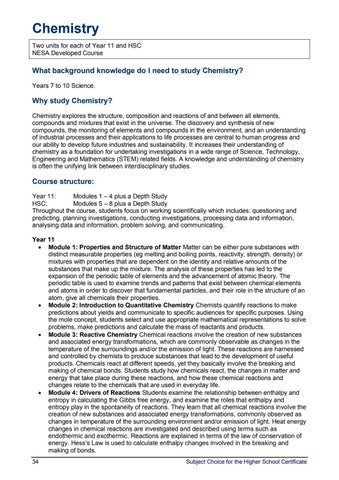Chemistry Two units for each of Year 11 and HSC NESA Developed Course
What background knowledge do I need to study Chemistry? Years 7 to 10 Science.
Why study Chemistry? Chemistry explores the structure, composition and reactions of and between all elements, compounds and mixtures that exist in the universe. The discovery and synthesis of new compounds, the monitoring of elements and compounds in the environment, and an understanding of industrial processes and their applications to life processes are central to human progress and our ability to develop future industries and sustainability. It increases their understanding of chemistry as a foundation for undertaking investigations in a wide range of Science, Technology, Engineering and Mathematics (STEM) related fields. A knowledge and understanding of chemistry is often the unifying link between interdisciplinary studies.
Course structure: Year 11: Modules 1 – 4 plus a Depth Study HSC: Modules 5 – 8 plus a Depth Study Throughout the course, students focus on working scientifically which includes: questioning and predicting, planning investigations, conducting investigations, processing data and information, analysing data and information, problem solving, and communicating. Year 11 • Module 1: Properties and Structure of Matter Matter can be either pure substances with distinct measurable properties (eg melting and boiling points, reactivity, strength, density) or mixtures with properties that are dependent on the identity and relative amounts of the substances that make up the mixture. The analysis of these properties has led to the expansion of the periodic table of elements and the advancement of atomic theory. The periodic table is used to examine trends and patterns that exist between chemical elements and atoms in order to discover that fundamental particles, and their role in the structure of an atom, give all chemicals their properties. • Module 2: Introduction to Quantitative Chemistry Chemists quantify reactions to make predictions about yields and communicate to specific audiences for specific purposes. Using the mole concept, students select and use appropriate mathematical representations to solve problems, make predictions and calculate the mass of reactants and products. • Module 3: Reactive Chemistry Chemical reactions involve the creation of new substances and associated energy transformations, which are commonly observable as changes in the temperature of the surroundings and/or the emission of light. These reactions are harnessed and controlled by chemists to produce substances that lead to the development of useful products. Chemicals react at different speeds, yet they basically involve the breaking and making of chemical bonds. Students study how chemicals react, the changes in matter and energy that take place during these reactions, and how these chemical reactions and changes relate to the chemicals that are used in everyday life. • Module 4: Drivers of Reactions Students examine the relationship between enthalpy and entropy in calculating the Gibbs free energy, and examine the roles that enthalpy and entropy play in the spontaneity of reactions. They learn that all chemical reactions involve the creation of new substances and associated energy transformations, commonly observed as changes in temperature of the surrounding environment and/or emission of light. Heat energy changes in chemical reactions are investigated and described using terms such as endothermic and exothermic. Reactions are explained in terms of the law of conservation of energy. Hess’s Law is used to calculate enthalpy changes involved in the breaking and making of bonds. 34
Subject Choice for the Higher School Certificate




